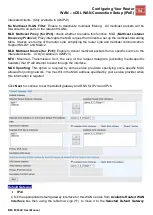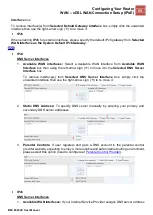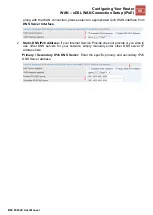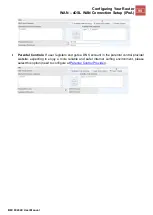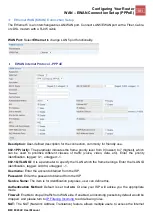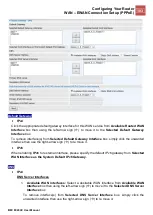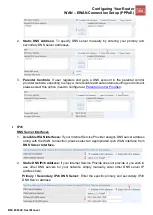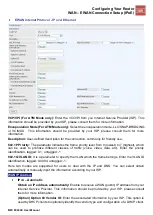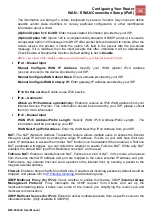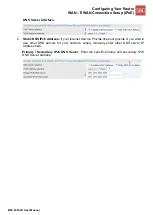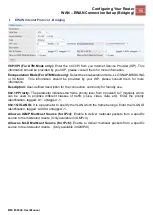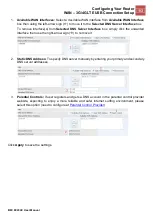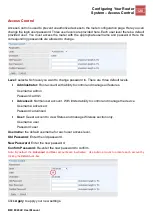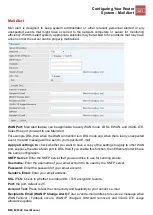
Configuring Your Router
WAN
– EWAN Connection Setup (IPoE)
106
BEC 8920AC User Manual
The information is a string of n octets, interpreted by servers. Vendors may choose to define
specific vendor class identifiers to convey particular configuration or other identification
information about a client.
(Option) Option 61 ClientID:
Enter the associated information provided by your ISP.
(Option) Option 125:
Option 125 is a complementary standard of DHCP protocol, it is used to
encapsulate option 125 message into DHCP offer packet before forward it to clients. After the
clients receive the packet, it check the option 125 field in the packet with the pre-stored
message, if it is matched, then the client accepts this offer, otherwise it will be abandoned.
Check Enable or Disable this function. Default setting is set to
Disable
.
NOTE: Leave them blink / disable unless you are instructed by your Internet Service Provider.
IPv4
– Manual Input
Manual Configure WAN IP Address:
Specify your WAN (public) IPv4 address
(xxx.xxx.xxx.xxx) to the device provided by your ISP.
Manual Configure WAN Subnet Mask:
Enter submask provided by your ISP.
Manual Configure WAN Gateway IP:
Enter gateway IP address provided by your ISP.
IPv6 for this service:
Enable to use IPv6 service.
IPv6
– Automatic
Obtain an IPv6 address automatically:
Enable to receive an IPv6 WAN address from your
Internet Service Provider. This information should be provided by your ISP, please consult
them for more information.
IPv6
– Manual Input
WAN IPv6 Address/Prefix Length:
Specify WAN IPv6 Address/Prefix Length. The
information shall be provided by your ISP.
WAN Next-Hop IPv6 Address:
Enter the WAN Next-Hop IPv6 Address from your ISP.
NAT:
The NAT (Network Address Translation) feature allows multiple users to access the Internet
through a single IP account by sharing the single IP address. If users on your LAN have their own
public IP addresses to access the Internet, NAT function can be disabled. When enabled, a Fullcone
NAT parameter will appear, you can determine whether to enable Fullcone NAT. While only NAT
enabled, the default NAT type Port-Restricted cone NAT will be used.
Fullcone NAT:
Enable or disable fullcone NAT. Fullcone is a kind of NAT, in this mode, all requests
from the same internal IP address and port are mapped to the same external IP address and port.
Furthermore, any external host can send a packet to the internal host, by sending a packet to the
mapped external address.
Firewall:
Enable to drop all traffic from WAN side. If enabled, all incoming packets by default would be
to add allowing rules.
IGMP Multicast Proxy (for IPv4):
Check whether to enable this feature. IGMP (
Internet Group
Management Protocol
) Proxy intercepts the IGMP request from Clients and set up the
multicast-
forwarding table, it takes over some of the router’s job, simplifying the router’s job and
multicast communication.
IGMP Multicast Source (for IPv4):
Enable to deliver multicast packets from a specific source to the
interested clients. (Only available in IGMPv3)



